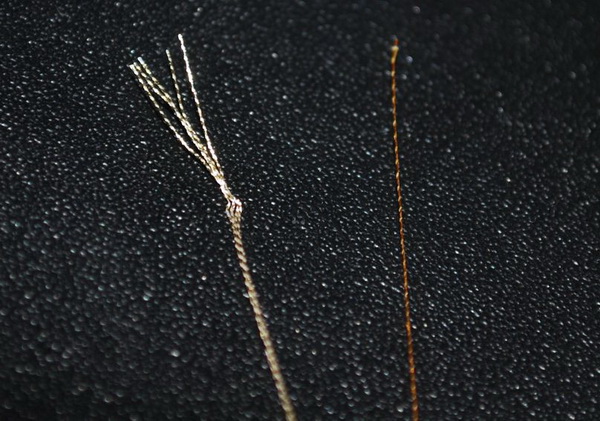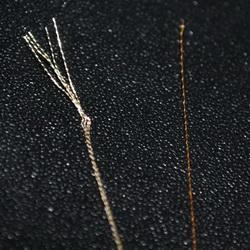Original text by Marina Belova
Besides the standard metallic embroidery threads, which are exactly of the same thickness as the ordinary rayon or polyester threads (#40), manufacturers offer an enormous range of metallic threads of varying thickness and texture. There can be thinner #50 metallic threads for precise handling of the details. And also thick threads from #35 and up to #8.
These threads arouse interest because of their thickness they allow to achieve the three-dimensional effect and create texture. In my opinion, they will be splendid for machine embroidering sacred images — imitating metallic thread couching. Especially if you use a colored thread instead of a standard bobbin thread, and if you also loosen the tension so that the thread forms some loops on the front side. Who knows all the cases where these threads can be used! Beside artistic effects, the use of metallic threads allows reducing the stitch count in the fill patterns by means of lowering the density, which is quite important.
Madeira makes very thick threads of that kind, and they are marked FS. Rheingold offers practically the same color and size range, but for a lower price (they are manufactured at the same factory as Madeira threads). Amann, too, has a textured thread called Mety 30. Unfortunately, in order to buy threads of that kind you'll have to run off your feet — they are not easy to find in my country, even in Moscow.
How should one use them? The information available is sparse, as usual. But you don't need to invent anything, just to make sense of what the manufacturers write on the subject. And if you already used supertwist or thick acrylic (woolen) or cotton threads in your embroidery, there will be much fewer questions.
A thick thread of that kind is made of several twisted thin fibers. On the photo below you can see an ordinary metallic thread on the right, and on the left is Mety 30 made of 5 strands, each constructed of still thinner fibers:

Technically the embroidery process with these threads will look like this:
You'll need thicker needles, corresponding to the thickness of each thread. This is what Madeira recommends:
A #90/14 needle will be suitable for #35 and #30 metallic threads, a #100/16 needle for #20, #15 and #12 metallic threads, and a #110/16 needle — for #10 and #8 threads.
In order to insert such a «multi-layered» thread in the needle's eye, you'll need to make a flat knot. Otherwise, the task will prove extremely difficult.
You'll also need to loosen up the tension, but in such a way that the nasty "bird nests" do not appear.
Using a thin bobbin thread like ISA 180 is preferable.
Machine's speed should be reduced to 650—750 rpm.
Don't forget to choose the appropriate stabilizer.
As for creating the design, you'll need to expend some effort.
Pick a big design. Leave all details to be embroidered with the ordinary threads.
Set the density of the satin stitches, as well as tatami filling stitches, as follows:
- #35 — 0.45 mm
- #30 — 0.5 mm
- #20 — 0.8 mm
- #15 — 0.9 mm
- #12 and thicker — 1 mm and more.
When modifying a ready (machine embroidery) file you can try to upscale the design. Start with the 10% increase. But you'll have to perform many tests to evaluate the result. Therefore, in my opinion, it is easier to digitize the design for thick threads. At least in those parts where the textured thread will be used.
Stitch length is no less than 3—3.5 mm. This is true for running stitches as well as for satin stitches and filling stitches.
Designs filled with tiled patterns look particularly effective when embroidered with the threads of this kind.
The number and density of the understitching should be kept to a minimum. Especially regarding the use of the very thick threads — you simply won't need much understitching. It will give the extra thickness, which many embroidery machines, home ones in particular, hardly manage to stitch.
But how beautiful is the result! And besides, it does not require too much of an effort.

Edited by Irina



There are no reviews to display.